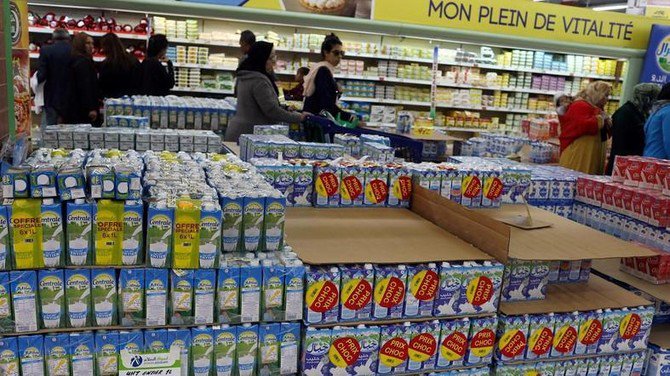
LONDON: In April, a series of posts appeared on Facebook and Twitter, urging the people of Morocco not to buy Danone brand fresh milk as a protest against the company’s high prices.
Within weeks, Centrale Danone, which is French-owned, lost 40 percent of its sales and suffered a net loss of €13.5 million in the first half of 2018.
It did not stop there. The company employs 6,000 people in Morocco but did not renew contracts with more 880 temporary workers as it was forced to cut milk production by 30 percent. That led to disgruntled employees protesting in front of the national parliament against the boycott which threatened their livelihoods.
Two months later, in June, the chief executive of Danone, Emmanuel Faber, arrived in Morocco to “listen and understand the reasons for the boycott from the people on the ground.”
In September, after a consultation exercise lasting weeks, Faber announced a cut in the price of fresh pasteurised milk and revealed a new, cheaper semi-skimmed milk-in-a-pouch. He also declared that despite its troubles, Danone “will never leave Morocco.”
As well as Danone milk, protesters targeted Sidi Ali mineral water and Afriquia petrol stations.
“It was an incredible campaign,” said Soraya El-Kahlaoui, a lecturer in Morocco. “It involved all types of people — working class, the bourgeoisie — and it got the result everyone wanted.”
The Danone boycott in Morocco succeeded because it was about more than milk prices. It was also about popular struggle.
“For any protest to succeed, people have to be mobilized, they have to be persuaded of the rightness of a cause,” said John Chalcraft, professor of Middle East history and politics at the London School of Economics. As a tool of protest, boycotting can be both powerful and safe, he added. “People have a role without the risk of ending up in prison. No one can accuse them of breaking the law.”
Nor is it new to the Middle East. In 1890, Iranians revolted en masse against the Shah granting a tobacco concession to Britain. The deal gave the Imperial Tobacco Corporation of Persia a monopoly over the production, and sale of tobacco for 50 years. In return, the Shah, Nasir Al-Din, was to be paid £15,000 a year (equivalent to $2.35 million today) plus a share of the profits.
FASTFACTS
With products sold in over 120 markets, Danone generated sales of €24.7 billion in 2017.
Coming on top of other concessions granted to foreigners, this was too much. Persian tobacco was much prized and at the time the industry employed more than 200,000 people. The first protests were organized by bazaaris (merchants) but the clergy soon joined in, issuing a fatwa against tobacco consumption. The merchants closed the bazaars and Iranians — such heavy smokers that they even lit up in mosques — gave up smoking. Beaten by the boycott, the Shah canceled the concession in January 1892.
Just as the tobacco boycott was a protest against exploitation by the rich, so the inflated milk prices in Morocco were seen as evidence of collusion between big business and the government.
“It would not be stupid to compare that earlier period with the contemporary one,” said Chalcraft. “Boycott is a familiar form of protest in the Middle East.”
In 1945, the Arab League adopted a boycott of all Israeli goods. Six years later, they extended the boycott to anyone trading with Israel. The blacklisted companies included big names such as Revlon, Bulova Watches and the Chase Manhattan Bank. The boycott ended gradually. Egypt dropped out in 1979, Jordan and the Palestinian Authority in 1994 and finally, the GCC in 1994.
It was partly revived in 2005 when Palestinians launched the Boycott, Divestment and Sanctions (BDS) movement against Israel, and more particularly against goods emanating from or being sold in the settlements in the Occupied Territories.
Patrick Barwise, emeritus professor of management and marketing at London Business School, doubts the effectiveness of boycotts.
“The buying behavior of most consumers is much less affected by ethical concerns than they might claim in response to a survey,” he said. “Tech firms such as Facebook, Amazon and Uber have been widely criticized for some of their business and labor management practices but very few consumers have stopped using them on those grounds.”
Danone said the milk boycott was in reality a wider protest against the high cost of living in Morocco. After conducting a wide public consultation exercise over the summer, involving nearly 10 million people, Danone reduced the price of a 470ml pack of milk down to what it was 10 years ago.
The milk boycotters’ slogan was “Khali i rib” — “let the milk flow.” Danone adopted the same slogan as it tried to rebuild consumer trust.
“It hasn’t worked,” said Soraya El-Kahlaoui. “The image of the brand is very damaged.”




















